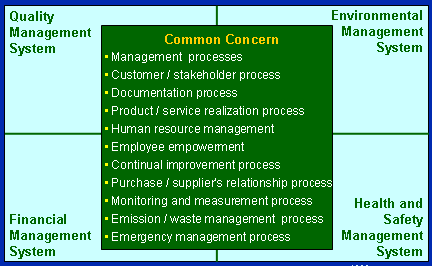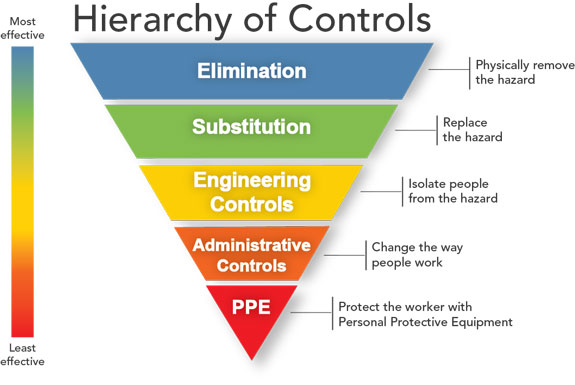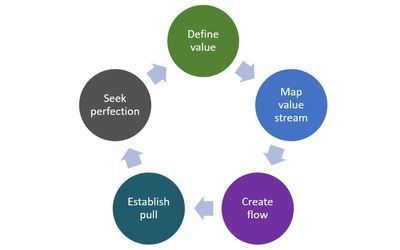Lean Six Sigma: Quality Management on Steroids
When I was in college, the extent of Lean Six Sigma I learned about was within my Safety Management course. It was only a slide or two of information, but it directly caught my attention as a means of problem solving complex issues.
The topic we were discussing that day was a Systems Approach to Safety, utilizing the principles from W. Edwards Deming. We then discussed Quality Management Systems and how they are tied into Safety Management Systems.
During my co-op capstone internship, the company I worked for utilized Lean Six Sigma within all departments. My manager, who was the Environmental, Health, Safety, Security and Continuous Improvement manager, taught me principles of Lean Six Sigma. I obtained my Yellow Belt through spearheading two projects which led to a return on investment for the facility.
Lean and Six Sigma Described
Lean and Six Sigma did not originate together. They begun as separate techniques and evolved to become utilized in unison. Six Sigma is a problem solving technique, while Lean reduces various aspects of waste within a process.
Six Sigma Described
As stated by Jack Benton in “How Can Six Sigma Improve Your Safety Performance”, six sigma is quality on steroids. Six sigma originated as a means to improve quality management systems (Total Quality Management TQM) by removing causes of defects. Jack states, “In safety, these process defects can be unsafe behaviors, incorrect procedures or equipment failures, all of which can result in injury.”
The Total Quality Management process begun with the Plan, Do, Check, Act (PDCA) process. This is a common standard for improving any system an individual is working with. Below is an example from Jack Benton which does a great job demonstrating the PDCA for safety.
PDCA to DMAIC
There are over 20 tools within six sigma, and the demand grew to use these tools in an efficient approach. Eventually, DMAIC, a process integrating all of the tools within six sigma, was created. Within each of the process steps, various tools can be utilized to develop an improvement solution.
DMAIC and the statistical tools are beneficial to display the entire problem-solving process. This development shows the progress of the project from baseline metrics, analyzed information, to solution opportunities and means of sustaining a project. Consider the following thoughts when beginning the process:
- Define
- Identify the process and define the scope of the project
- Clearly identify the inputs and outputs of the process
- Measure
- Evaluate the measurement systems and resulting data
- Analyze
- Determine the cause-and-effect relationships
- Identify the root cause of the defects
- Improve
- Develop and implement improvements
- Test effectiveness of improvements
- Control
- Implement a system to sustain the improvements
SMART Goals
While learning the process of six sigma, I was taught to integrate SMART goals into the DMAIC process. SMART goals help determine I am choosing a specific project scope, resources and support are available, if the goal is important, and how I will identify success.
As a safety professional, a project is considered important based on the severity of an injury – what is the probability, frequency and ultimately severity of an injury? Some questions to consider when creating SMART goals are:
- Specific
- What exactly needs to be accomplished?
- Who else will be involved?
- Where will this take place?
- Why do I want to accomplish this goal?
- Measurable
- How will I know I’ve succeeded?
- How much change needs to occur?
- How many accomplishments or actions will it take?
- Attainable
- Do I have, or can I get, the resources needed to achieve the goal?
- Is the goal a reasonable stretch for me? (Neither out of reach or too easy).
- Are the actions I plan to take likely to bring success?
- Relevant
- Is this a worthwhile goal for me right now?
- Is it meaningful to me – or just something others think I should do?
- Would it delay or prevent me from achieving a more important goal?
- Am I willing to commit to achieving this goal?
- Time-Bound
- What is the deadline for reaching the goal?
- When do I need to take action?
- What can I do today?
Hierarchy of Controls
Along with SMART goals, adding the Hierarchy of Controls pyramid to the Analyze and Improve steps of DMAIC is highly valuable.
The Hierarchy of Controls is extremely important – personal protective equipment (PPE) should always be the last resort and considered the least effective during any process improvement. The most effective control would to be eliminate the hazard, however, it is not always possible.
Some best methods of control may be a combination of various aspects in the pyramid. Engineering and administrative changes may be necessary in a machine guarding or ergonomic hazard. While, engineering controls may be effective to eliminate respirator usage in an air quality environment over the permissible exposure limit (PEL).
Six Sigma Tools
At the beginning of the continuous improvement project, tools are picked out which would best describe the represented information. There are many tools to choose from and choosing the right ones are important to best communicate project data.
It seems like a rabbit hole when thinking about the entire project. It was easier to document my thought-process with each of these steps before the structure of the project is organized.
Six Sigma Thought-Process Planning
- Integrate SMART goals into DMAIC
- Complete the SMART goals first
- Choosing the right statistical tools to represent project information
- There may be more than 1 tool per DMAIC section to use
- Depending on the scope of the project, using 2 or 3 tools for each section is ideal
- This is especially true in the Measurement and Analysis sections to discover the root causes
- Incorporate Hierarchy of Controls into the Analyze and Improve steps
The great thing about six sigma is the process is laid out. Each of the steps and tools you would use on the steps lay the framework for the problem-solving thought-process. This helps to ensure there is nothing which is left not thought of. Being extremely thorough in a complex issue is especially important, as there are more than likely multiple root causes.
Six sigma is a method for process improvement, process design, and process management.
Lean Described
So I am going to change thought-process almost completely – Lean.
Lean is problem-solving, however, it varies from six sigma. Lean’s purpose is solely the elimination and reduction of waste from people, material and information. A term commonly used within this process is ‘non-value added’. Six-Sigma-Material.com does a great job at laying out all the resources and definitions of the process and tools involved within Lean Manufacturing.
Below is the process associated with lean to eliminate and reduce waste:
Process and Tools
- Voice of the Customer and Value Proposition
- Usually a reduction in lead time not only increases working capital, but makes the process quicker, more responsive, and flexible. This is value.
- Value Stream Mapping
- This tool is also an important part of most six sigma projects which creates a Current and Future state to “Lean” out a value stream. It quickly identifies opportunities to reduce lead time. The focus is on operational tactics rather than finance functions.
- Remove Constraints and Enable Flow
- Perform constraint analysis by studying Takt Time and Loading charts, they can create a picture where to focus improvements.
- Implement Pull
- The use of Workcells (5S), Kanban cards (manufacturing only what is required in the moment), Waste removal, and Visual Management
- Check and Act
- If a change needs to be made based on something not working, act to modify the improvement
When to Use Lean and/or Six Sigma
The scope of the improvement will be able to determine what problem solving means to use.
Lean is used when there is a waste or non-value added to a process. This may include:
- Speed
- Increasing speed often adds automation, improving ergonomics
- Cycle Time
- 6S
- Wasted motions (ergonomics)
- Standardization
- Policies/procedures/expectations
- Inventory Performance
- Verify if proper PPE/safety equipment is utilized
- Quality equipment, on time may be an issue
- Logistics Cost Reduction
- Speed and/or Cycle Time decreased
- Variance Reduction
Six Sigma is used for complex problems. These problems may include:
- Variation reduction
- Streamline policies/procedures/expectations
- Process capability
- Improving overall safety performance
- Safety leadership
- Defect prevention
- Incident investigations
- Stability, predictability
- Hazard identification, reporting and mitigation process
- Design excellence
- Injury reduction
- Decreasing injury severity
- Work methods design
- Safety training
- Behavioral based safety
- Human error
- Safety cultural assessments
While overall Lean and Six Sigma are used for larger problems, smaller quick fixes are necessary wins as well. In this case, Kaizens would be utilized. Kaizens are for simple tactical focus areas and obvious quick fixes.
Conclusion
There is a considerable amount which could be covered within the topics of Lean Six Sigma. Obtaining my Green Belt is on my goals list, as is utilizing these tools of problem-solving to achieve EHS objectives.
An extensive amount of effort went into the Lean Six Sigma projects I have completed. I have learned a lot about how management systems and problems can be solved using the DMAIC process. This helps to simplify continuous improvement efforts and streamline successes within various departments of a company.
To select the project objective, proactive and/or reactive data can be analyzed. We are looking for the largest risk priority. Frequency * probability = severity. Rank risks within proactive and reactive information to prioritize resource efforts. Use the largest risk to set a SMART goal. Keep this information as a process of brainstorming for the project.
Use the brainstorming information as a means to begin setting up the skeleton of DMAIC. Take each step one at a time. Ensure each step is thorough and complete before moving on to the next. Look for ways the Hierarchy of Controls can be utilized to eliminate or decrease the risk to a tolerable level.
Before any improvement is fully implemented, test it to ensure it works for its intended users (employees/procedures). If it does not work, tweak it until you are comfortable with the level of risk. MAKE SURE THERE IS A CONTROL. WE NEED TO MAKE SURE THE CHANGE IS SUSTAINABLE.
No improvement will be successful unless there is a system in place to sustain the improvements – whether it be integrated into a process or needs to be manually accounted for through administrative procedures.
Yes, this was a lot of information! This is a topic I enjoy and hold close to what I practice out in the field. Commit and prioritize resources to what the data is telling you!
Until next time,

Works Cited
- Jack, Benton. “How Six Sigma Can Improve Your Safety Performance.” EHS Safety News America. 5 April, 2014. https://ehssafetynewsamerica.com/2014/03/26/how-six-sigma-can-improve-your-safety-performance/.
- Seivert, Jody. “Getting Ready for the New Year.” Selling Interior Design. 12 December, 2014. https://sellinginteriordesign.com/2014/12/12/getting-ready-for-the-new-year/.
- “Lean Manufacturing.” Six Sigma Material. https://www.six-sigma-material.com/Lean-Manufacturing.html






